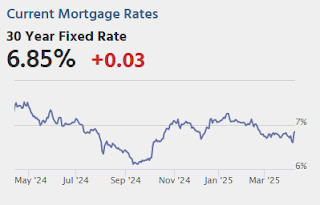Realtor.com Reports Active Inventory Up 30.3% YoY
What this means: On a weekly basis, Realtor.com reports the year-over-year change in active inventory and new listings. On a monthly basis, they report total inventory. For March, Realtor.com reported inventory was up 28.5% YoY, but still down 20.2% compared to the 2017 to 2019 same month levels.
Now - on a weekly basis - inventory is up 30.3% YoY.
Realtor.com has monthly and weekly data on the existing home market. Here is their weekly report: Weekly Housing Trends View—Data for Week Ending April 5, 2025 Here is a graph of the year-over-year change in inventory according to realtor.com.
Here is a graph of the year-over-year change in inventory according to realtor.com.
Inventory was up year-over-year for the 74th consecutive week.
New listings have increased but remain below typical pre-pandemic levels.
Median prices are mostly unchanged year-over-year.
Now - on a weekly basis - inventory is up 30.3% YoY.
Realtor.com has monthly and weekly data on the existing home market. Here is their weekly report: Weekly Housing Trends View—Data for Week Ending April 5, 2025
• Active inventory climbed 30.3% from a year ago
The number of homes actively for sale remains significantly higher than last year, continuing a 74-week streak of annual gains. This year-over-year inventory growth gives buyers more choices and encourages more competitive pricing among sellers. Generally, the number of homes up for sale is still below pre-pandemic norms, and the long-standing supply gap will continue to put pressure on prices in under-supplied areas.
• New listings—a measure of sellers putting homes up for sale—increased 8.6%
New listings were up 8.6% compared with this time last year, marking the 13th straight week of annual growth.
• The median list price increased 0.1% year over year
The national median list price was up 0.1% compared with a year ago, marking the first year-over-year increase after 44 weeks of flat or declining prices. However, more data is needed to determine whether this modest growth signals a true turnaround. In particular, recent economic uncertainty may dampen buyer interest, potentially putting downward pressure on prices.
 Here is a graph of the year-over-year change in inventory according to realtor.com.
Here is a graph of the year-over-year change in inventory according to realtor.com. Inventory was up year-over-year for the 74th consecutive week.
New listings have increased but remain below typical pre-pandemic levels.
Median prices are mostly unchanged year-over-year.






















Recent comments